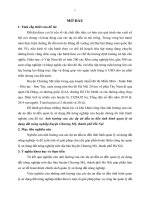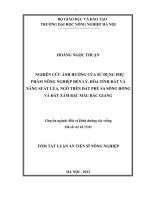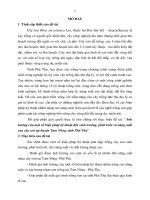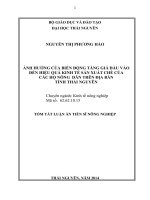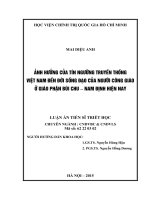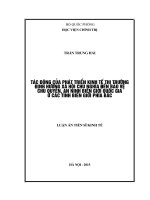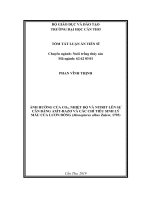Luận án tiến sĩ ảnh hưởng hiệp đồng cùa lá sắn (manihot esculenta crantz), bã bia, và than sinh học (biochar)
Bạn đang xem bản rút gọn của tài liệu. Xem và tải ngay bản đầy đủ của tài liệu tại đây (1.06 MB, 148 trang )
HUE UNIVERSITY
UNIVERSITY OF AGRICULTURE AND FORESTRY
LE THUY BINH PHUONG
SYNERGIC EFFECT OF CASSAVA (MANIHOT
ESCULENTA CRANTZ) FOLIAGE, BREWER’S GRAINS,
AND BIOCHAR ON METHANE PRODUCTION AND
PERFORMANCE OF RUMINANTS
DOCTOR OF PHILOSOPHY IN ANIMAL SCIENCES
HUE, 2020
HUE UNIVERSITY
UNIVERSITY OF AGRICULTURE AND FORESTRY
LE THUY BINH PHUONG
SYNERGIC EFFECT OF CASSAVA (MANIHOT
ESCULENTA CRANTZ) FOLIAGE, BREWER’S GRAINS,
AND BIOCHAR ON METHANE PRODUCTION AND
PERFORMANCE OF RUMINANTS
SPECIALIZATION: ANIMAL SCIENCES
CODE: 9620105
DOCTOR OF PHILOSOPHY IN ANIMAL SCIENCES
SUPERVISOR 1: ASSOC. PROF. NGUYEN HUU VAN
SUPERVISOR 2: DR. DINH VAN DUNG
HUE, 2020
Declaration
I declare that this dissertation is the result of my work and that it has not been presented
previously as a dissertation at this university or elsewhere. To the best of my
knowledge, it does not breach copyright law, and has not been taken from other sources
except where such work has been cited and acknowledged within the text. All results
have been published at Journal of Livestock Research for Rural Development (LRRD)
/>Hue University, 2020
Le Thuy Binh Phuong
3
Dedication
To my parent who spends their immense loves to me.
To my husband, Than Van Dang, and my two daughters, Than Ngoc Kim Nguyen and
Than Ngoc Hai An, who encouraged me to pursue my dreams.
Acknowledgements
4
My Ph.D. has been an amazing experience with Professor Thomas Reginal Preston. He
has been teaching me how good experiment is done and how to be real researcher. I have
been grown up like that, thus, I would like to thank with all my heart to his guidance.
I am thankful to Professor Ron A. Leng who gave me the background knowledge in
biochemistry for stimulating the ideas in research.
I would like to thanks to Assoc. Prof. Nguyen Huu Van and Dr. Dinh Van Dung who
gave me the most helpful advice and instructed me to complete the dissertation.
I gratefully acknowledge financial support from the SIDA-financed project,
MEKARN II for 3 years that made my Ph.D. work possible.
My classmate in Ph.D. course, the group is source of friendship as well as good
collaboration.
Lastly, I would like to thank my family for all their love and encouragement. For my
parents who take care of my children during course time and support me to participate
in learning and research activities. Most of all for my loving, supportive, encouraging,
and patient husband Dang who faithful support during the final stages of this Ph.D. is
so appreciated. Thank you.
5
Abstract
This dissertation was aimed to develop a greater understanding of both the
constraints in the presence of cyanide toxin and benefits of using cassava foliage as
bypass protein in order to improve its utilization in ruminant feeding systems.
The study comprised two in vitro rumen incubations, one feeding trial on cattle and
a digestibility/N retention experiment on goats, in each case involving comparisons of
varieties of cassava known to be rich (KM94) or poor (Gon) in cyanogenic glucosides.
In the first experiment (Chapter 2), cassava foliage varieties (Japan, KM94, KM140
and Gon) with different level of cyanide concentration were considered their effect on
methane production in ruminal in vitro incubation. The second experiment (Chapter 3)
examined the relative responses of cattle fed cassava root pulp and urea as basal diet
with foliage from “sweet” (Gon) or “bitter” (KM140) cassava foliage as protein source.
The third experiment (Chapter 4) determined methane production in an in vitro rumen
incubation of cassava pulp - urea with additives of brewers’ grain, rice wine yearst
culture, yeast-fermented cassava pulp and leaves of sweet or bitter cassava variety. The
fourth experiment (Chapter 5) measured effect of additives (brewer’s grain and biochar)
on the nitrogen retention and rumen methane production when goats had access to
mixed sweet and bitter varieties of cassava foliage compared with the sweet variety
alone.
The results of these experiments indicated that bitter cassava foliage containing high
levels of cyanogenic glucosides greatly reduces methane production, compared with
sweet varieties, in the rumen in vitro incubations. However, the toxicity of cyanide in
vivo in ruminants (cattle and goats) can be reduced by “prebiotic” properties provided by
either brewers’ grains or biochar. In the presence of these “prebiotics”, HCN-linked
challenges from feeding bitter cassava leaves at up to 50% of the diet of goats did not
negatively impact to feed intake, growth and animal health. On the contrary, the HCN
precursors present in bitter cassava leaves may lead to a partial shift in digestion of
nutrients from the rumen to the lower parts of the ruminant digestive tract leading to
improvement in productivity.
Key words: Prebiotic, cyanide, bitter cassava, rumen fermentation, in vitro.
6
Table of Contents
List of Figures
7
List of Tables
8
Abbreviation
ADG
Average daily gain
ATP
Adenosine tri-phosphate
ADF
Acid detergent fiber
BG
Brewers’ grain
CP
Crude protein
CF
Crude fiber
CFU
Colony-forming unit
DM
Dry matter
DMI
Dry matter intake
EPS
Extracellular polymeric substances
EE
Ether extract
HCN
Hydrocyanic acid
GE
Gross energy
9
LW
Live weight
MOS
Manna-oligosaccharide
N
Nitrogen
NADH
Nicotinamide adenine dinucleotide hydride
NDF
Neutral detergent fiber
NPN
Non-protein nitrogen
RDP
Rumen degradable protein
Phosphoenolpyruvate
PEP
Standard error mean
SEM
UDP
Un-degradable protein
VFA
Volatile fatty acid
10
INTRODUCTION
1. Problem statement
Cassava is perspective plant to climate change adaptation; its pests and its diseases
resistance and greater drought tolerance is a major factor in ranking cassava in the food
security of the world (Jarvis et al. 2012). In Vietnam, cassava is second crop, is grown
mainly in both at the household and small-scale processor level (Hoang Kim et al.
2000). From the successful experiment in utilization of cassava foliage (sweet variety)
as protein source on cattle which was originally reported by Ffoulkes and Preston
(1978), and then have been successfully fed as fresh state to goat and cattle in
Cambodia (See report of Preston and Rodríguez Lylian, 2004), that make cassava
foliage become important plant protein source in ruminant diet. Nevertheless, cyanide
toxin in fresh cassava foliage, especially bitter cassava foliage, is the main obstacle for
animal such as restricting the consumption intake of ruminant or causing poisoning
when they consume rapidly. Currently, as the quantity of bitter cassava (high cyanide
content) develop more predominant than sweet cassava (lower cyanide content) on the
field, utilization of bitter cassava foliage in diet will match reality more; however,
looking for feeding method of minimizing negative effect of cyanide toxin, from that
can be utilized bitter cassava foliage in diet will more match reality but will a
challenge.
Many studies are beginning to be interested in cyanide toxic that has certain effect
on methanogenic bacteria population by inhibited methanogenesis activity lead to
diminish methane production (Ch Olga Rojas et al. 1999; Phuong et al. 2012;
Phanthavong et al. 2015). However, whether cyanide may affect overall microbial
activity and impact the rate of rumen fermentation indirectly, it is still not fully
understood. Previously, the knowledge of ruminant nutritionists focused on rumen, but
the impact of cyanide on rumen fermentation may profoundly influence lower digestive
physiology of ruminant and must be considered to fully understand when utilizing bitter
cassava foliage in diet. Even so, the challenge of bitter cassava foliage diet (high
cyanide content) is a new approach but must require the safety for animal's health.
11
Therefore, building appropriate feeding method for fresh cassava foliage diet,
particularly bitter cassava foliage, without cyanide poisoning is needed to utilize
cassava foliage more effective in the ruminant feeding system.
2. Aim and objective of the study
2.1 Aims of the study
The aim of this thesis was to develop a greater understanding of both the constraints
and benefits of using cassava foliage in ruminant feeding systems. From these things
can improve the utilization of cassava foliage in ruminant feeding by enhancing its
properties as a source of bypass protein and verify the role of HCN toxin in cassava
foliage on the reduction of methane production that was built on earlier findings.
2.2 Objective of the study
The following objectives are required to accomplish the aim of this research:
i
Determining the trend influences of HCN concentration in cassava foliage
on the characteristic of in vitro rumen fermentation such as gas and methane
production, ammonia concentration.
ii
Considering the benefit of brewers’ grain to “bitter” cassava foliage (KM94)
diet by examining Saccharomyces and acid lactic bacteria in fresh brewers’
grain and compare it with potential fermented cassava pulp on gas and
methane production of ruminal in vitro incubation.
iii
Building feeding method of “bitter” cassava foliage (KM 94 variety;
moderate HCN content) diet by added 4% brewers’ grain (of DM) and/or
1% biochar (as DM), then evaluating the effects of this feeding method on
growth, digestibility/N retention, excretion of thiocyanate in urine and
methane production of cattle and goat.
3. Research hypotheses
The research hypothesizes following:
i
Higher HCN content in bitter cassava foliage would be more effective in
reducing methane production in both rumen in vitro incubations and in vivo
experiment rather than foliage from a sweet variety (low HCN content).
12
ii
By added 4% brewers’ grain and/or 1% biochar in bitter cassava foliage
(KM94 variety) diet would lead to: (1) improving the growth rate of cattle
fed a basal diet of cassava pulp-urea; and (2) increasing N-retention,
reducing thiocyanate in urine of goats having free access to both bitter and
sweet cassava foliage.
4. Significant/Innovation of study
This dissertation successfully demonstrated that HCN in cassava foliage is main
factor for reduction of methane production while the earlier finding could only predict
the role of HCN for decreased methane. Currently, the best-known cassava foliage to
feed animal is “sweet” cassava foliage with low cyanide content, my dissertation
succeeds to build feeding method for “bitter” cassava foliage diet (higher cyanide
content) with support of adding restricted brewers grain (4% of DM) and biochar (1%
of DM) to feed cattle and goats without cause HCN toxicity. Additionally, discovery of
the feeding of the bitter cassava foliage appear to modify the rumen fermentation lead
to increases in nitrogen retention associated with reduced methane production, it made
a part of this dissertation provided the implication for new approach of the proposed
partial shift in sites of digestion (from rumen to small intestine and the cecal-colon
region) that previously it is thought that only rumen fermentation has a truly symbiotic
relationship with the ruminant.
CHAPTER 1. LITERATURE REVIEW
13
1.1 Rumen fermentation and methane production
1.1.1 Rumen fermentation
Understanding rumen fermentation is an important step in applying the basis
knowledge to improve rumen function and utilizing feed efficiency. Rumen microbial
fermentation is crucial for growth and production of ruminants. Although there are
many kinds of microbes have been found in the digestion of ruminant, yet it is thought
that only ruminal microbes have a truly symbiotic relationship with the host until now.
Individual rumen microbial species have developed in a complex process of evolution
extending over a long period and provide nature's best example of microbial symbioses.
Rumen ecosystem is a self-contained ecosystem, the feed is fermented by ruminal
microbes to end products along with microbial biomass, is the source of energy and
protein to respond to essential nutritional needs for ruminant.
With diverse anaerobic microbes in the rumen, ruminant is able to degrade the
complex fiber source to provide nutrient essential is readily digested by the host while
this is completely restricted on non-ruminant (Owens and Basalan 2016). The rumen
contains a variety of microorganism including main groups such as bacteria, fungi, and
protozoa. In which bacteria is considered majority microbes with a diversity of bacteria
genera that its classification base on the preference for certain substrates. There are
three forms for the distribution of bacteria in the rumen, free-floating bacteria constitute
a minor component (~30 %), and bacteria adhere on feed particle account for the largest
population with 70%. Both bacteria groups mainly participate in the digestion of feed.
The last distribution form is bacteria that attach to the ruminal epithelial cells. They do
not make any significant contribution on feed digestion, but it is assumed that they may
scavenge oxygen to maintain an anaerobic medium. Otherwise, epimural bacteria
produce urease enzyme to hydrolyze urea (Nagaraja et al. 2016), this allows ruminant
can use urea more efficient than non-ruminant.
The cellulose-degrading bacteria are able to degrade cellulose, one of the
components in the cell wall of plant. They include Ruminococcus albus, Fibrobacter
succinogenes and Ruminococcus flavefaciens (Valente et al. 2016). Cellulolytic bacteria
prefer neutral pH between 6 and 9 is for best maintenance and growth, with pH of less
14
than 5.5, it would affect fiber digestibility. Cellulolytic bacteria release cellulase
enzyme that can catalyze the β-1, 4-glycosidic bonds of cellulose to provide glucose for
its growth. Amylolytic bacteria mainly include Streptococci bovis, Bacteriodes
ruminicola, Ruminobacter amylophilus, Selenomonas ruminantium, Succinomonas
amylolítica. These bacteria can debranch starch to produce monosaccharide and
ferment them to end products such as VFA, formate, and acid lactic. Streptococci bovis
can change its metabolite to produce acid lactic as a final product when there is much
highly fermentable ingredient such as grain or concentrate in diet, is the cause of
acidosis in the rumen (Castillo-Gonzáleza et al. 2014). The pH value, in this case, can
drop to lower 5.5, causes extreme inhibition of cellulolytic bacteria. To avoid this case,
the requirement of gradually introducing fermentable carbohydrate to animal and the
balance ratio of starch and cellulose in feeding system is necessary. For proteolytic
activity, there are many strain and species of rumen contain a different type of
proteolytic enzyme. They include ciliate protozoa, bacteria, and anaerobic fungi that
have been found to be proteolytic (Wallace 1996). In which, the main proteolytic
bacteria have been reported to include Bacteroides amylophilus, Bacteroides
rutminicola, and Butyrivibrio fibrisolvens. The proteolytic activity has also been
reported in Streptococcus bovis and Prevotella albensis (reviewed by CastilloGonzáleza et al. 2014). This bacteria group is major responsible for dietary protein
breakdown while protozoa proteolysis both particulate feed protein of appropriate size
and also bacteria protein (Wallace 1996). Some report showed that proteolytic bacteria
were affected in population decline when the presence of condensed tannin in the diet
(McSweeney 1999; Min et al. 2003). However, Min et al. (2003) also reported that
microbial protein outflow to the abomasum was unchanged in this case. This means
that although tannin binding protein to reduce the activity of microbial enzymes, and to
reduce the growth rate of proteolytic bacteria but increasing by-pass protein to respond
to demand for animal protein.
Fungi represent a small proportion, approximately 8% of the biomass in the ruminal
ecosystem (Jenkins et al. 2008). The rhizoidal development of fungi cell allows them to
penetrate plant tissue better than bacteria and protozoa, which would weaken the
15
structure of plant and greater in degradation of forage. Ruminal fungi produce phenolic
esterases (p-coumaroyl and feruloyl) that can break cross-linkages between
hemicelluloses and lignin, which allow the fungus would have increased access to
hemicelluloses (Nagaraja 2016). Thus, fungi degrade cellulose more efficient than the
main species of ruminal cellulolytic bacteria. Most of the ruminal fungi can use di or
monosaccharide as substrate effectively.
Protozoa can contribute up to 50% of biomass in the rumen, it can be eliminated
from ruminal environment but does not affect much ruminal fermentation. Newbold et
al. (2015) demonstrated that elimination of ciliate protozoa increases microbial protein
supply by up to 30% and reduces methane production by up to 11%. Protozoa act as
micro-ruminants continually engulfing and digesting both small feed particles and
bacteria (Owens et al. 2016), by this way, defaunation is applied to increase the cause
of increasing bacteria density. Ruminal protozoa harbor methanogen on the outside
surface and inside the cell (Nagaraja 2016), metabolism of protozoa also produces
methanogen’s substrate such as H2 for reducing CO2 to form methane. Thereby, it is
considered that the removal of protozoa decreases methanogenesis due to reduction of
available H+ for methanogens (Mosoni et al. 2011).
In term of overall biochemical metabolism, ruminal microbes secrete enzyme that
hydrolysis all macromolecule such as polysaccharide, protein, lipid and other
compounds to monomer that after then fermented to the intermediate substrate (VFA,
ammonia, ATP...). The main purpose of rumen fermentation is to generate energy for
maintenance and synthesis processes of microbial polymers which leads to the
synthesis of more microbial cells which in turn increases available protein to the animal
(Phuong 2012).
1.1.2 Volatile fatty acid pattern
When ruminal microbes fermented soluble sugar, they produce VFAs and ATP that is
considered energy source and is re-utilized for maintenance and growth of microbes.
Acetic acid, butyric acid, and propionic acid are the majority component of VFAs and
largely part was absorbed via rumen wall as free form. After passing into hepatic portal
blood, they circulate as anion having a net negative electrical charge (acetate,
16
propionate and butyrate) at blood pH (Voan Soest 1982). Acetate may enter mainly
fatty synthesis via actyl-CoA intermediate than is ketone body due to it must not pass
through this stage metabolism, while partly butyrate is interconverted to ketone bodies
(acetoacetate, β-hydroxybutyrate) in the liver, the excessive accumulation of ketone
bodies is result in ketosis as a pathological condition of the ruminant. Propionic acid is
concerned as precursor of glucose synthesis with 80% propionate into blood transferred
to hepatic for gluconeogenesis (Van Soest 1982). Preston and Leng (1987) cited that
propionate may contribute 80-90% of the glucose synthesized in sheep on roughage
diets (Cridland 1984). With by-product diet or dry pasture, poorly absorbed glucose
thus gluconeogenesis plays the major role to provide glucose needed for ruminant,
while some starch escape fermentation in grain-based diets can be digested in the small
intestine.
Figure 1.1 Pathway of VFA in metabolism
PEP=phosphoenolpyruvate
Source: Voan Soest (1982)
Therefore, the ratio of acetic and propionic (Ac/Pro) is calculated as indicating a
parameter for animal production. The higher acetate concentration may require filling
the gap by propionate and high Ac/Pro may be an indication of the insufficient for
gluconeogenesis.
1.1.3 Protein metabolism
The ruminal microbes are likely to utilize non-protein nitrogen source (NPN) such
as urea to contribute ammonia pool in the rumen. Level of ammonium in rumen regard
17
to microbial output due to microbes is likely to convert ammonium to protein for
synthesis microbial polymer. The low ammonium indicated nitrogen shortage to
microbes lead to low fermentation rate, in contrast, excessive ammonium is result in
ammonium toxicity for the animal. Nevertheless, in order to utilize NPN effectively, the
conversation of ammonium to microbial protein requires the availability of ATP energy
generated by fermentation of carbohydrates. In other words, it requires the balance
between carbohydrate and NPN in diet. In term of N digestion from non-NH 3N flow
into small intestine, mainly in duodenum, account for 65% of nitrogen from animal’s
feeding (MacRae and Ulyatt 1974) due to the extent of conversation of protein to NH 3N in rumen is faster than using NH3-N of ruminal microbes into pathway of microbial
protein synthesis (Ulyatt et al. 1975). Approximately 60% of amino acids absorbed
through the small intestine is from a bacterial protein, and the remaining 40% is from
ruminal un-degraded dietary protein (Wattiaux 1991). In addition, the ruminant can use
effective sources of bypass protein from by-product source.
The term of bypass protein in rumen fermentation is defined protein escape the
degradation of ruminal microbes. Two important factors influencing amount of protein
bypassing degradation in the rumen are the length of time spent in the rumen and
fermentability of protein (Miller 2012). Leng et al. (1981) indicated that bypass protein
in ruminant diet was postulated on stimulating feed intake, influencing the efficiency of
microbial cell yield and digestion in small intestine, providing amino acids post ruminal
digestion which are used efficiently, and in addition to increasing the total energy
intake. With too soluble protein as sole diet in rumen, dietary protein can be lost due to
largely part of essential amino acid is fermented by microbes, and microbial protein
would escape rumen to lower digestion to compensate protein needed of the animal,
meanwhile, the by-pass protein can provide essential amino acids that are synthesized
into animal tissues, via absorption from digested feed.
Non-degradable and degradable protein play an important role in rumen function
and animal efficiency. Although it has not been well defined the desirable proportion of
non-degradable and degradable protein in ruminant feeding, but there was quite evident
to believe that diet must contain sufficient both proteins to rise efficient productivity
18
(Miller 2012). There are many studies to be interested in searching the most effective
ratio of rumen degradable protein and un-degradable protein (RDP: RUP). Wang et al.
(2008) and Tacoma et al. (2017) did not found the significant difference among ratios
of RDP: RUP on milk yield, milk composition, and dry matter intake, but reducing the
ratio of RDP: RUP reduced N excretion in urine and faeces lead to enhance the
efficiency of N utilization. Savari et al. (2018) suggested that an RDP: RUP ratio of
65:35 could be adequate for cows in early lactation with an average milk production of
44 kg and a DMI of 25kg.
1.1.4 Methane production
Methane gas is produced from rumen fermentation by ruminal microbes.
Domesticated ruminant represents a loss of 2–15% of the gross energy (GE) intake by
methane production (Holter and Young 1992), therefore being one of most important
factors involve to inefficiencies in ruminant production systems (Moss et al. 2000).
In the rumen, methanogens are a large and diverse group of Archaea. By isolation
method,
it
is
Methanobrevibacter
classificated
smithii,
such
as
Methanobrevibacter
Methanobrecibacter
millerae,
ruminantium,
Methanobrevibacter
olleyae, Methanobacterium formicicum, Methanobacterium bryantii, Methanosarcina
barkeri, Methanosarcina mazai and Methanomicrobium mobile (Qiao et al. 2014).
Overall, the methanogen can be divided into two groups: H 2/CO2 and acetateconsumers with different level of energy yielding (-130.7 kJ/mol substrate and -32.3
kJ/mol substrate respectively). The distribution of methanogen is diverse, it is assumed
that they are free-swimming in fluid or attach to digested solid or attach to protozoa
(Morgavi et al. 2010)
Pathway of methane production
The pathway of methanogenesis has yet to be fully defined due to the diverse
microbes in rumen create overall synergistic and antagonistic interactions. However, it
had been known that formate, carbon dioxide, methanol, and acetate derived from
carbohydrate fermentation to be concerned as terminal electron receptor for hydrogen
to form methane (Figure 1.2). Based on biochemistry pathway, hexose metabolism via
the Emden-Meyerhof-Parnas pathway (EMP) which produces pyruvate as an
19
intermediate associated with cofactor NADH generation (Leng 2011). In methane
production, CO2 substrate is concerned to as an electron acceptor to form methane, this
pathway predominates in metabolism of hydrogenotrophic methanogen. This bacterium
group also use formate as an important electron donor and estimated up to 18% of the
methane produced in the rumen. Many of involved syntrophs are able to produce both
H2 and formate, and most of methanogenic partners are able to oxidise both substrates
to methane (Leng 2014). Acetate as substrate produce methane through the acetoclastic
pathway by Methanosarcina group but in terms of energy order, the energy level of
methane production from acetate is very low, lead to Methanosarcina population is
limited in rumen (Morgavi et al. 2010). Furthermore, largely acetate is absorbed into
bloodstream of animal, thus, the hydrogen would be contributed mainly by CO 2 to
methanogenesis (Galand et al. 2014)
Figure 1.2 The reaction of methane generation
The process of methane production requires in low hydrogen partial pressure,
which is necessary for continual fermentation in the rumen (Figure 1.3). However, the
inhibition of methanogenesis would redirect available hydrogen into alternative energyyielding metabolic pathways which are expected to improve the productivity of
ruminant but do not adversely affect ruminal metabolism. Martinez-Fernandez et al.
(2016) had a comprehensive assessment on methanogenesis inhibition by adding
different levels of chloroform on steer fed roughage hay versus hay: concentrate, the
result showed that increasing chloroform level would enhance the expel of hydrogen
but there was no effect both on dry matter intake and on fiber degradation. The critical
issue was found in this study is that expelled H 2 per mole of decreased methane was
lower on steer fed roughage hay alone in diet compared to hay: concentrate. The
evaluation of rumen microbial response in this study showed that decreasing of in
Archaea and in Synergistetes for both diets accompanied with increasing in
20
Bacteroidetes (the bacteria involve to propionate production), but did not change
fibrolytic bacteria, fungi, and protozoa. These results can conclude that hydrogen was
redirected into other products than into CH4 and H2, probably in microbial protein, it can
be expected to improve performance of animal. Furthermore, using roughage hay in
diet is the suggestion in slow fermentation that creates a condition for microbes
utilizing H2 more effectively as a reduction of methane production, meanwhile, highly
fermented concentrates in diet would high partial pressure of H2.
Figure 1.3 The pathway of hexose conversation to end-products
(Source: Bernalier et al. 1999)
1.1.5 Effect of feeding system on rumen fermentation
Feeding system has generally the direct effects on the rumen fermentation pattern
because of the various chemical compositions among the ingredients and then has
impact on ruminant performance. Nolan and Dobos (2005) identified that the feature of
fresh forage diet is highly soluble protein and carbohydrate that it would increase the
crude protein degradation, meanwhile, crude protein in dried-forage and cereal grain is
generally less degradable protein and is considered as bypass protein (or un-degradable
protein). Beside the balance of energy and protein in rumen fermentation, along with
soluble characteristic of feed, perspective of feed utilization is also depended on the
21
activity of microbe’s consortia (communication of bacteria groups and fungi) when it was
applied to issues related to increasing fiber digestibility (Firkins 2010).
Asizua et al. (2018) compared three feeding systems that has using agro-industrial
byproduct in steers, particularly those that are cereal based: (1) natural sole grazing
(control), (2) control plus concentrate supplement (composition g/kg DM: 375 maize
bran, 559 brewer's spent grain, 62.5 molasses and 3.75 NaCl), and (3) feedlot systems
where steers were fed total mixed ration (TMR) comprising g/kg DM: 200 maize stove,
300 maize bran, 447 brewers’ spent grain, 50 molasses and 03 NaCl. The higher
ammonia-nitrogen (NH3-N) concentration in sole grazing steers compared with grazing
plus concentrate supplement and feedlot system reflected the deviation between
digestible energy and nitrogen metabolism in the rumen, or the imbalance ratio of C:N.
Highly inclusion of maize bran and molasses as fermentable carbohydrate in feedlot
system showed cause of higher VFA and lower pH within the range for sub-acute
ruminal acidosis (SARA) of 5.0–5.6 compared with sole grazing. This experiment also
showed that the lower degradation of DM, CP and NDF in feedlot system and grazing
plus concentrate supplement compare to sole grazing is as a result of highly soluble
carbohydrate intake. It is well known that declined cellulolytic bacteria activity caused
by pH value in rumen drop to 6.5 on high-grain diets (Krause et al. 2003). These
showed that critical factor affected on rumen fermentation is mainly the type of feed
rather than feeding system.
Fibrous carbohydrate (green grass, rice straw…) is one of critical requirement of
ruminal microbes, forage is incorporated with concentrate tend to increase protein,
energy, mineral and vitamin. Nevertheless, the feeding of high concentrate in diet in
prolongation is cause of VFA accumulation and lower pH value. Therefore,
determination of appropriate ratio of forage and concentrate (F: C) is being looked for.
Most studied showed that increasing ratio of F: C in diet corresponded to higher
methane production (Benchaar et al. 2001, Aguerre et al. 2011, Seon-Ho et al. 2018).
The diets that being rich in fiber content have tend to increase acetate production
because of abundant acetate producing bacteria (Marques et al. 2017). In contrast, non22
fiber carbohydrate in diet oriented mainly propionate production and resulting in lower
of methane emission (Valadares et al. 1999).
1.2 Understanding ruminal microorganism
1.2.1 The self-detoxify mechanism of ruminal microbes
Grazing forage-based ruminant is likely to get plant toxins such as tannins,
alkaloids, goitrogens, gossypol, saponins, glucosinolates, mimosine, fluoroacetate,
cyanogens, and mycotoxins. However, the ruminant is less susceptible to toxins than
mono-gastric due to fermentation in the rumen can reduce toxicity by microbial
metabolism in the foregut (Leng 2017). With good fiber digestion, ruminal microbes
are likely to detoxify many substances prevalent in certain plants and herbs that can
prove toxic for non-ruminants (Owens and Basalan 2016). These authors are thought
that the suggested detoxification by ruminal microbial requires ingestion of low dose
toxin and gradual increasing its concentration, it facilitates microbes can adapt and
increase biochemistry of metabolism for detoxification or be increasing the sorption of
toxins to prevent animals from choosing poison feed. This was demonstrated in series
of experiments using nitrate as fermentative N replace to urea in cattle (Sangkhom et al.
2012; Sophal et al. 2013) and goat (Trinh Phuc Hao et al. 2009; Silivong et al. 2011;
Sophea et al. 2011) without manifestation of poisoning during the experiment. Gradual
adaptation of nitrate in diet allows ruminal microbes to convert nitrate to ammonium
directly. Smith (1992) reviewed that ruminant can increase tolerance of some plant
toxic when they have gradually adapted to the toxin such as nitrate, nitrite,
nitropropanoic acid, oxalate, prussic acid (cyanogenic glycosides), sulfate and sulfide,
some alkaloids (e.g., mimosine) and, perhaps, even some mycotoxins. This author also
mentioned that activated charcoal has been effectively used to adsorb some kinds of
poisons and prevent their absorption by animal. In summary, rumen microorganisms are
likely to establish a detoxification mechanism; however, to be achieved high efficiency
requires the coordination of microorganisms to act in concert.
23
1.2.2
Interaction
of
ruminal
microorganism
in
biofilm
formation
The requirement of microbes, in general, to attach to solid materials, become sessile
and form biofilms was recognized in the 1970s, largely through the laboratories of
Professors Costerton (Costerton 2007). The natural microorganism has two types of
growth: (1) a unicellular life phase, the cells are free-swimming (planktonic), (2) a
multicellular life phase in organized consortia within biofilms encased in self-produced
extracellular
polymers
(EPS)
which
constituent
of
complex
mixture
of
exopolysaccharides, nucleic acids, proteins, and other compounds (Leng 2017). The
induced signals are emitted by an individual cell of microorganism being a form of cellto-cell communication for formation and growth of biofilm (Berlanca and Guerrero
2016). The activity of microorganisms in biofilm is an integration of metabolic
processes, generate intermediate such as H 2, H2S, NH3, several organic compounds,
electron acceptors (O2, SO42-, CO2, etc.), waste products, and other substances that
establishes the driving forces that lead to the formation of the chemical gradients and
allowing molecular diffusion (Stewart et al. 2008). According to Leng (2011), the
growth of biofilm includes the following phases:
1. Initial (reversible) attachment of cells to the surface by adhesions, receptors and nonspecific mechanisms that rely on physical-chemical forces such as van-der Waals forces.
2. Irreversible attachment by production of EPS resulting in more firmly adhered.
3. Maturation I. Early development of biofilm architecture.
4. Maturation II. Maturation of biofilm architecture, attachment of other organisms,
competition, organization to create pores, channels.
5. Dispersion of single cells from the biofilm.
Biofilm does not exist forever, at the end of the decline phase, the biofilm breaks down
and releases single cells. The consecutive releasing of the previous biofilms facilitates
the formation of subsequent surface links and formed new biofilm (Berlanca and
Guerrero 2016).
The biofilm formation in the rumen is similar to the above description; biofilm mode
of living enhances the rate of reaction related to fermentation through the self-organised
24
and closely associated assembly of sessile bacteria/Archaea attached to the matrix
(Leng 2017). It is inevitable for the growth of ruminal microbes and ruminant’s health.
Leng (2014) stated that highly solubilization of feed organic matter requires the
attachment of many different ruminal microorganisms on the surface of feed particle to
access the nutrient, particularly adhere to the damaged edge by chewing of ruminant;
consequently, EPS membrane is formed. In this population, fungi grow deeper into the
plant structure, especially also at previously damaged sites of feed particle, but closely
associated with EPS of fermentative biofilm. Fungi weaken plant structure by
hydrolytic enzymes such as cellulases, hemicellulases, proteases, amylases, feruloyl
and p-coumaryl esterases, various disaccharidases, pectinases, and exonucleases.
Consequently, reducing the size of the feed particle and creating the opportunity for
other microorganisms to access substrate fermentation. In biochemistry activity of
ruminal biofilm, the sugar or starch is glycolyzed to form volatile fatty acids (VFAs), N
compound convert to ammonium which is used to synthesize bacteria cell. The pressure
of H2, is mostly produced in VFAs formation, play the key role in methane production.
The high pressure of H2 allows diffusing the outer layer of the biofilm, making
methanogenesis prefer to embed on this layer to take their H 2 substrate. However, not
only methanogenesis is concentrated in the outer layer of biofilm, but also
methanotrophic group used methane as substrate for methane oxidation.
To be
effective in capturing methane substrate, methanotrophic would be distributed close to
methanogenesis that may be located in the outer layer biofilm where having the highest
methane pressure (Leng et al. 2011). Although diffusion of intermediate compounds
such as VFAs, amino acids and ammonia (NH3), and gases such as CH 4, H2 and carbon
dioxide (CO2) could get into or out of biofilm but the concentration of this material can
be expected more higher in a matrix of biofilm than in external rumen fluid (Leng
2014). Therefore, both the methanogenesis and methanotrophic tend to attach in biofilm
than free-swimming (planktonic) in rumen fluid.
The absence of protozoa did not
affect fermentation activity, as well as the ruminant's health, was found via de-fauna
protozoa process by oil (Beauchemin and McGinn 2006). The single protozoa group
was reviewed the most in many studies on biofilm protozoan. They included naked
25
